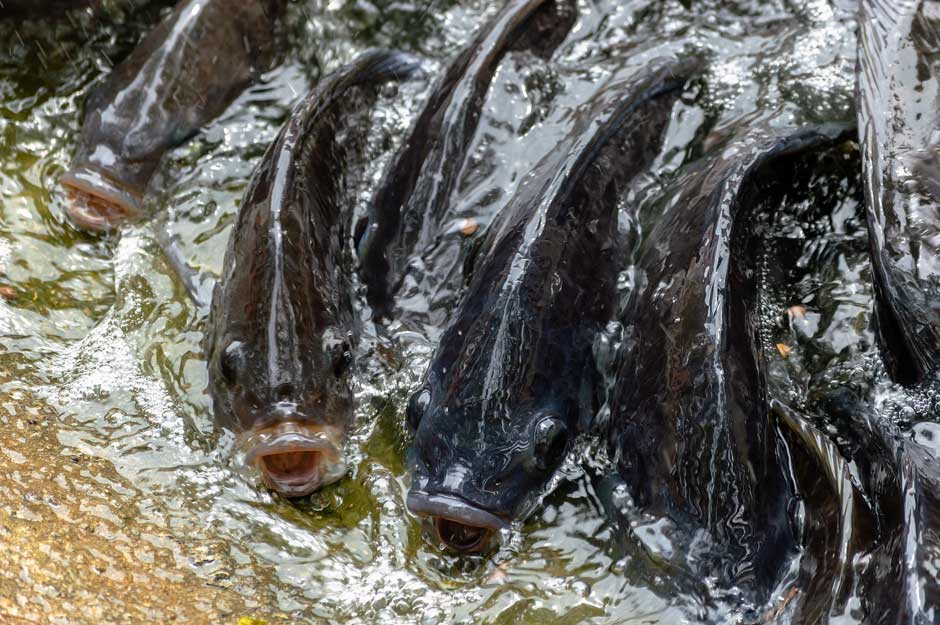How Do Fish Respond to Low Dissolved Oxygen?

Hypoxia is a state of low dissolved oxygen in water. It’s a growing issue in marine coastal waters around the world, but aquaculture ponds are susceptible to crashing dissolved oxygen levels as well, to the great detriment of the fish growing there.
In fact, because aquaculture ponds are often intensively farmed and smaller bodies of water, dissolved oxygen levels can change drastically from day to day, even within a single day. High levels of nutrients and photosynthesizing organisms mean the dissolved oxygen balance is a delicate one.
But, what’s the big deal? What does it actually mean for fish health and growth?
Fish, shrimp and shellfish grown in aquaculture settings react to dissolved oxygen deficiencies at different levels and in different ways. Below, we’ll look at a few of hypoxia’s effects on fish, both in aquaculture and in the wild. While the effects of low dissolved oxygen differ from species to species, we can make several generalizations: low dissolved oxygen is something to avoid and no profitable species benefits from it.
Dissolved oxygen levels influence fish size and efficiency
In a study examining the effect of oxygen saturation and the growth of halibut, researchers found that halibut grew slower at oxygen levels that were too low.
(Oxygen saturation is a related but distinct concept from dissolved oxygen levels. Dissolved oxygen levels are a measure of the number of oxygen molecules as compared to molecules of water. The measurement is usually given in units of parts per million or mg/L. Oxygen saturation is measured as a percentage and gives the amount of oxygen in water relative to the amount of oxygen that could be dissolved in the water under a certain set of conditions, like temperature, salinity and pH.)
In this study, halibut were raised in tanks at oxygen saturation levels of 60%, 80%, 100%, 120% and 140%. The experiment showed that the fish raised in water between 80% and 120% oxygen saturation grew more than the fish raised at 60% and 140%.
What’s more, at the upper and lower extremes of saturation, 60% and 140%, the halibut were less efficient at turning food into weight.
Similar results were found in mulloway, which grew slower in hypoxic waters. Interestingly, the study showed that mulloway were able to maintain their swimming speed in slightly hypoxic water by using resources that, under normal conditions, would be used for other purposes, like growth. The study notes this is likely an adaptation specific to mulloway.
Many different species of fish experience effects of hypoxia on their swimming behavior. Reactions differ from species to species, but several trends hold. Slow swimming fish swim slower, while fast might swim as if they were agitated. Likewise, schooling fish might form smaller, more sluggish schools. In general, fish limit their swimming when less oxygen is available.
An experiment on turbot showed that in conditions of hypoxia, they ate less and converted less food into weight. Turbot did show some ability to adapt to hypoxic waters, though. Certain chemical balances in their bodies were unchanged at normal and lower levels of dissolved oxygen.
Low dissolved oxygen has a harmful effect on fish reproduction too. It can reduce fertilization success and slow down the development of embryos. If not enough dissolved oxygen is available at certain points in an embryo’s development, it can disrupt the growth of reproductive organs and, once the young hatch, they are less fit to survive, and fewer do.
Even fish seemingly adapted to survive with low dissolved oxygen struggle in hypoxic waters. Snakefish, a fish commonly raised in aquaculture ponds in Asia, have adapted to breath air. They’re so good at it, they can survive short stints out of water. But, when these fish are stuck in hypoxic waters, they can’t digest food as efficiently as they had before. A similar dynamic has been shown in Atlantic cod in the wild (though they do not breathe air).
Shellfish harmed by low dissolved oxygen
It’s not just finned fish who struggle in hypoxic conditions.
In shrimp, another animal commonly raised in aquaculture operations, low dissolved oxygen had a variety of effects. Research shows that hypoxia disrupts the internal chemistry of a shrimp, leading to chemical imbalances and possible organ damage. Other research showed that shrimp exposed to low dissolved oxygen levels did not gain weight as quickly as those in normal water. But, if shrimp were given enough time in water with enough dissolved oxygen, they were able to achieve normal weight by eating more than normal, a condition known as hyperphagia.
Clams, mussels and oysters also feel the effects of hypoxia. Clams have been shown to survive a single, extended hypoxic event, but died at higher than normal rates when experiencing a second instance of hypoxia. Oysters contracted and had worse effects from certain diseases. And, in mussels, hypoxia is known to compound the effects of acidifying oceans.
Hypoxia has a variety of impacts on any number of aquaculture fish. What’s common across all the examples given above is that fish don’t have the resources they need to add weight rapidly and efficiently. A greater percentage of their limited resources goes to maintaining their basic internal functions. They just don’t have the resources to put toward converting food to weight. Even in cases that don’t lead to mortality, it can make it a more likely outcome later.
But, many fish can survive and recover, given that the hypoxic events are small enough. Still, the best approach to low dissolved oxygen is working to ensure it doesn’t happen in the first place.
Success starts with careful and constant dissolved oxygen monitoring.
Top image: Oysters, like the ones grown on this farm, and other common aquaculture raised animals can feel the effects of low dissolved oxygen. (Credit: Max Nossin / CC BY 3.0)


0 comments